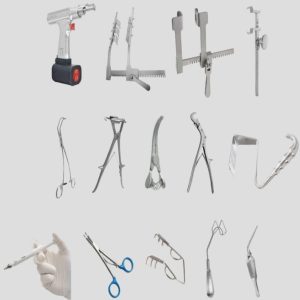The Ultimate Guide to Ophthalmic Equipment: Types, Uses, and Benefits

Definition of Ophthalmic Equipment
Ophthalmic equipment encompasses a wide range of devices used by eye care professionals to diagnose, treat, and manage eye conditions. These tools are essential in providing comprehensive eye care and improving patient outcomes.
Importance of Ophthalmic Equipment in Eye Care
The importance of ophthalmic equipment cannot be overstated, as it plays a crucial role in early detection and treatment of eye diseases. Advanced diagnostic tools enable precise assessment of ocular health, while innovative surgical devices facilitate effective treatment of various conditions.
Overview of Advancements in Ophthalmic Technology
Over the past few decades, there have been significant advancements in ophthalmic technology. Innovations such as Optical Coherence Tomography (OCT) and laser surgery have revolutionized the field, offering more accurate diagnostics and minimally invasive treatment options.
2. Types of Ophthalmic Equipment
Diagnostic Equipment
Slit Lamps
Slit lamps are essential tools in ophthalmology, providing a magnified, three-dimensional view of the eye. They are used to examine the anterior and posterior segments of the eye, aiding in the diagnosis of conditions like cataracts, corneal injuries, and retinal detachments.
Fundus Cameras
Fundus cameras capture detailed images of the retina, optic disc, and macula. These images are crucial for diagnosing retinal diseases, monitoring disease progression, and documenting changes over time.
Optical Coherence Tomography (OCT)
OCT is a non-invasive imaging technique that provides high-resolution cross-sectional images of the retina. It is instrumental in diagnosing and managing conditions such as macular degeneration, diabetic retinopathy, and glaucoma.
Surgical Equipment
Phacoemulsification Machines
Phacoemulsification machines are used in cataract surgery to emulsify and remove the clouded lens. This technology allows for smaller incisions, faster recovery times, and improved visual outcomes.
Vitrectomy Machines
Vitrectomy machines are utilized in vitreoretinal surgeries to remove the vitreous gel and repair retinal detachments, macular holes, and other complex retinal conditions.
Therapeutic Equipment
Lasers
Lasers are widely used in ophthalmology for both diagnostic and therapeutic purposes. They are employed in procedures such as LASIK, photocoagulation for diabetic retinopathy, and laser iridotomy for glaucoma.
Cryotherapy Units
Cryotherapy units use extreme cold to treat retinal tears and detachments. This technique is effective in preventing further retinal damage and promoting healing.
General Eye Examination Tools
Autorefractors
Autorefractors measure the refractive error of the eye, providing an objective assessment of a patient’s prescription. They are essential for determining the correct corrective lenses for patients.
Tonometers
Tonometers measure intraocular pressure (IOP), which is a critical factor in diagnosing and managing glaucoma. Elevated IOP can indicate a risk for optic nerve damage.
3. Symptoms and Signs of Eye Conditions
Common Eye Symptoms
Blurred Vision
Blurred vision is a common symptom of many eye conditions, including refractive errors, cataracts, and macular degeneration. It can affect one or both eyes and may be temporary or persistent.
Eye Pain
Eye pain can range from mild discomfort to severe pain and can be caused by various conditions, such as infections, injuries, and glaucoma. It is important to seek medical attention if eye pain persists.
Redness
Redness in the eye can be a sign of inflammation, infection, or irritation. Conjunctivitis, dry eyes, and allergies are common causes of eye redness.
Specific Signs of Major Eye Diseases
Glaucoma
Glaucoma is characterized by increased intraocular pressure, which can lead to optic nerve damage and vision loss. Early signs include peripheral vision loss, halos around lights, and eye pain.
Cataracts
Cataracts cause clouding of the eye’s lens, leading to blurred vision, glare, and difficulty seeing at night. They are common in older adults and can be effectively treated with surgery.
Macular Degeneration
Macular degeneration affects the central part of the retina, leading to loss of central vision. Symptoms include difficulty reading, recognizing faces, and seeing fine details.
4. Causes and Risk Factors of Eye Diseases
Genetic Factors
Many eye conditions, such as glaucoma and macular degeneration, have a genetic component. A family history of these diseases increases the risk of developing them.
Environmental Influences
Environmental factors, such as exposure to UV radiation, pollutants, and smoking, can contribute to the development of eye diseases. Protecting the eyes from these harmful influences is essential for maintaining eye health.
Lifestyle Factors
Lifestyle choices, including diet, exercise, and smoking, play a significant role in eye health. A balanced diet rich in antioxidants and regular physical activity can help prevent conditions like macular degeneration and cataracts.
5. Diagnosis and Tests
Comprehensive Eye Exams
A comprehensive eye exam includes a series of tests to evaluate visual acuity, refractive error, and overall eye health. Regular exams are crucial for early detection of eye conditions.
Imaging Tests
Ultrasound
Ocular ultrasound uses high-frequency sound waves to create images of the eye’s internal structures. It is used to diagnose conditions such as retinal detachment, tumors, and foreign bodies in the eye.
MRI
Magnetic Resonance Imaging (MRI) provides detailed images of the eye and surrounding tissues. It is particularly useful in diagnosing orbital tumors, optic nerve abnormalities, and other complex conditions.
Functional Tests
Visual Field Test
A visual field test measures the extent of a patient’s peripheral vision. It is an important tool for diagnosing and monitoring glaucoma and other conditions that affect peripheral vision.
Color Vision Test
Color vision tests assess a patient’s ability to distinguish between different colors. These tests are used to diagnose color blindness and other color vision deficiencies.
6. Treatment Options for Eye Diseases
Medications
Eye Drops
Eye drops are commonly used to treat conditions like glaucoma, dry eyes, and infections. They can help reduce intraocular pressure, provide lubrication, and deliver antibiotics directly to the eye.
Oral Medications
Oral medications may be prescribed for conditions such as infections, inflammation, and chronic diseases like glaucoma. These medications work systemically to address underlying causes of eye conditions.
Surgical Treatments
LASIK
LASIK (Laser-Assisted In Situ Keratomileusis) is a popular refractive surgery that corrects vision by reshaping the cornea. It is effective for treating myopia, hyperopia, and astigmatism.
Cataract Surgery
Cataract surgery involves removing the clouded lens and replacing it with an artificial intraocular lens (IOL). This procedure restores clear vision and improves the quality of life for patients with cataracts.
Non-Surgical Treatments
Vision Therapy
Vision therapy consists of exercises and activities designed to improve visual skills and processing. It is used to treat conditions such as amblyopia (lazy eye), strabismus (crossed eyes), and convergence insufficiency.
Lifestyle Adjustments
Making lifestyle adjustments, such as wearing protective eyewear, maintaining a healthy diet, and managing chronic conditions like diabetes, can help prevent and manage eye diseases.
7. Preventive Measures for Eye Health
Regular Eye Exams
Regular eye exams are essential for early detection and treatment of eye conditions. Adults should have a comprehensive eye exam every one to two years, while children should have their first exam at six months of age.
Healthy Lifestyle Choices
Diet
A diet rich in fruits, vegetables, and omega-3 fatty acids supports eye health. Nutrients like vitamins A, C, and E, along with zinc and lutein, help protect the eyes from damage.
Exercise
Regular physical activity improves overall health and can reduce the risk of conditions like diabetes, which can lead to eye problems. Exercise also promotes good circulation, which is beneficial for eye health.
Protective Eyewear
Wearing protective eyewear, such as sunglasses and safety goggles, shields the eyes from harmful UV rays and injuries. This is especially important for people who spend a lot of time outdoors or work in hazardous environments.
8. Personal Stories or Case Studies
Real-life Success Stories of Eye Treatments
Sharing real-life success stories of individuals who have undergone eye treatments can inspire and inform others. These stories highlight the positive impact of early detection and effective treatment.
Interviews with Patients
Interviews with patients who have experienced significant improvements in their vision can provide valuable insights into the benefits of ophthalmic treatments. Their personal experiences can offer hope and encouragement to others facing similar issues.
9. Expert Insights
Quotes from Ophthalmologists
Including quotes from ophthalmologists and other eye care professionals adds credibility to the article. Their expert opinions and advice can help readers understand the importance of eye care and the latest advancements in the field.
Advice on Eye Care
Expert advice on eye care, such as tips for maintaining healthy vision and preventing eye diseases, can empower readers to take proactive steps in caring for their eyes. This section should include practical, actionable recommendations.
10. Conclusion
Summary of Key Points
Summarize the key points discussed in the article, highlighting the importance of ophthalmic equipment, early detection, and effective treatment of eye conditions.
Call to Action for Regular Eye Check-Ups
Encourage readers to schedule regular eye check-ups and take proactive steps to maintain their eye health. Emphasize the importance of early detection and prompt treatment in preserving vision.
Go to Check – https://rigorinstruments.com/ophthalmic-surgical-instruments/
More Articles: https://usafulnews.com/



